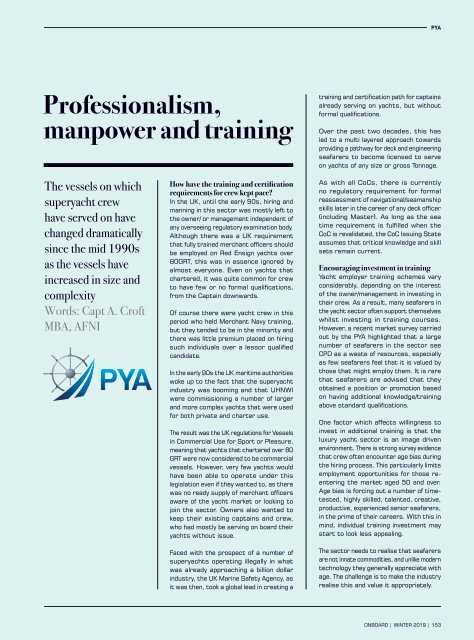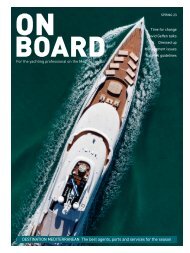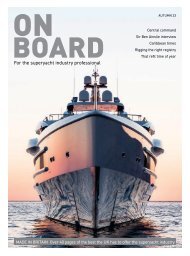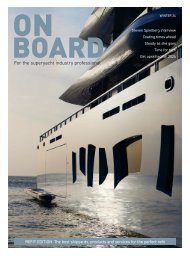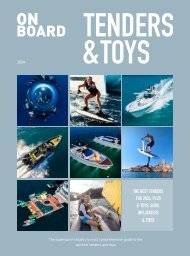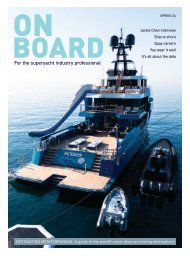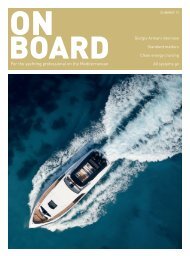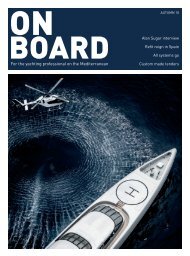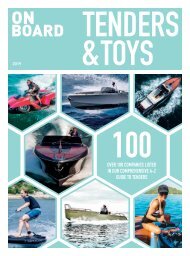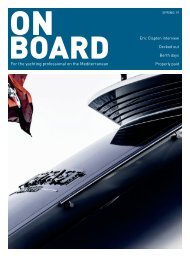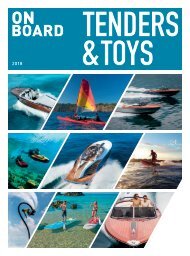ONBOARD Magazine winter 2019
You also want an ePaper? Increase the reach of your titles
YUMPU automatically turns print PDFs into web optimized ePapers that Google loves.
PYA<br />
Professionalism,<br />
manpower and training<br />
training and certification path for captains<br />
already serving on yachts, but without<br />
formal qualifications.<br />
Over the past two decades, this has<br />
led to a multi layered approach towards<br />
providing a pathway for deck and engineering<br />
seafarers to become licensed to serve<br />
on yachts of any size or gross Tonnage.<br />
The vessels on which<br />
superyacht crew<br />
have served on have<br />
changed dramatically<br />
since the mid 1990s<br />
as the vessels have<br />
increased in size and<br />
complexity<br />
Words: Capt A. Croft<br />
MBA, AFNI<br />
How have the training and certification<br />
requirements for crew kept pace?<br />
In the UK, until the early 90s, hiring and<br />
manning in this sector was mostly left to<br />
the owner/ or management independent of<br />
any overseeing regulatory examination body.<br />
Although there was a UK requirement<br />
that fully trained merchant officers should<br />
be employed on Red Ensign yachts over<br />
80GRT, this was in essence ignored by<br />
almost everyone. Even on yachts that<br />
chartered, it was quite common for crew<br />
to have few or no formal qualifications,<br />
from the Captain downwards.<br />
Of course there were yacht crew in this<br />
period who held Merchant Navy training,<br />
but they tended to be in the minority and<br />
there was little premium placed on hiring<br />
such individuals over a lessor qualified<br />
candidate.<br />
In the early 90s the UK maritime authorities<br />
woke up to the fact that the superyacht<br />
industry was booming and that UHNWI<br />
were commissioning a number of larger<br />
and more complex yachts that were used<br />
for both private and charter use.<br />
The result was the UK regulations for Vessels<br />
in Commercial Use for Sport or Pleasure,<br />
meaning that yachts that chartered over 80<br />
GRT were now considered to be commercial<br />
vessels. However, very few yachts would<br />
have been able to operate under this<br />
legislation even if they wanted to, as there<br />
was no ready supply of merchant officers<br />
aware of the yacht market or looking to<br />
join the sector. Owners also wanted to<br />
keep their existing captains and crew,<br />
who had mostly be serving on board their<br />
yachts without issue.<br />
Faced with the prospect of a number of<br />
superyachts operating illegally in what<br />
was already approaching a billion dollar<br />
industry, the UK Marine Safety Agency, as<br />
it was then, took a global lead in creating a<br />
As with all CoCs, there is currently<br />
no regulatory requirement for formal<br />
reassessment of navigational/seamanship<br />
skills later in the career of any deck officer<br />
(including Master). As long as the sea<br />
time requirement is fulfilled when the<br />
CoC is revalidated, the CoC Issuing State<br />
assumes that critical knowledge and skill<br />
sets remain current.<br />
Encouraging investment in training<br />
Yacht employer training schemes vary<br />
considerably, depending on the interest<br />
of the owner/management in investing in<br />
their crew. As a result, many seafarers in<br />
the yacht sector often support themselves<br />
whilst investing in training courses.<br />
However, a recent market survey carried<br />
out by the PYA highlighted that a large<br />
number of seafarers in the sector see<br />
CPD as a waste of resources, especially<br />
as few seafarers feel that it is valued by<br />
those that might employ them. It is rare<br />
that seafarers are advised that they<br />
obtained a position or promotion based<br />
on having additional knowledge/training<br />
above standard qualifications.<br />
One factor which affects willingness to<br />
invest in additional training is that the<br />
luxury yacht sector is an image driven<br />
environment. There is strong survey evidence<br />
that crew often encounter age bias during<br />
the hiring process. This particularly limits<br />
employment opportunities for those reentering<br />
the market aged 50 and over.<br />
Age bias is forcing out a number of timetested,<br />
highly skilled, talented, creative,<br />
productive, experienced senior seafarers,<br />
in the prime of their careers. With this in<br />
mind, individual training investment may<br />
start to look less appealing.<br />
The sector needs to realise that seafarers<br />
are not innate commodities, and unlike modern<br />
technology they generally appreciate with<br />
age. The challenge is to make the industry<br />
realise this and value it appropriately.<br />
<strong>ONBOARD</strong> | WINTER <strong>2019</strong> | 153


